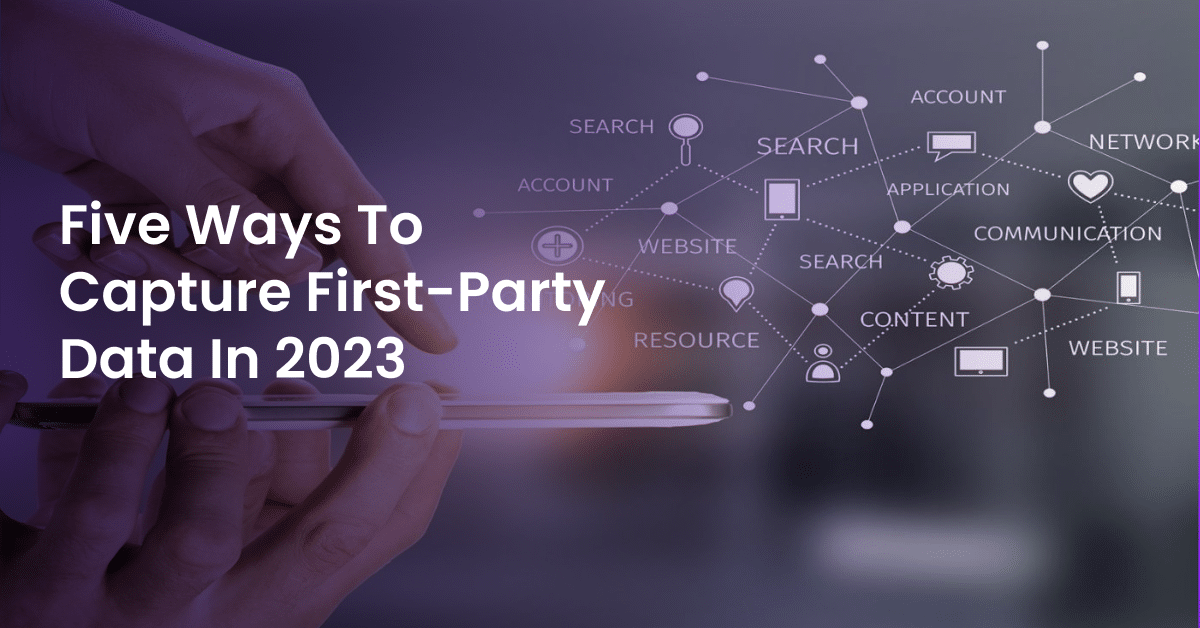

First party data is the future of online marketing because we’re entering the cookieless future. Third party cookies are effectively ceasing to exist because Apple and Google’s web browsers will no longer support them soon.
So, what’s your alternative to reach your online growth goals?
The single most important approach to thrive in the 2020s is to focus on capturing more first party data. First party data is data that your website users, mobile app uses and emails subscribers provide directly to you. There’s no middle man or intermediary who can change the rules or stop you from accessing first party data.

Why Gathering More First-Party Data Matters
Most companies we talk to have some level of first party data gathering in place. For instance, you have probably gathered website analytics data for years. Further, there’s a good chance that you also have a wealth of data from your email marketing platform. These sources of first party data are valuable and worth using. There’s just one drawback to them…
All of your competitors are likely using these forms of first party data already. It’s going to be tough to build a competitive advantage on that basis. The solution is to gather more data so that you can understand your audience better.
Five ways to gather better first-party data
Use these methods to level up your first party data gathering efforts. The first strategy to get more first party data is one of the most potent ways to better understand your audience.
1) Use online events and experiences
Your website has the ability to host online events and experiences for your audience with live chat technology. With Arena Live Chat, it’s easy to add a social interactive experience to your website.
As your audience participates in online events, you will gain additional first party data. As a starting point, you can identify your most engaged audience members through their participation in a chat session. Even more significant is the live chat log. By analyzing chat activity, you can see which topics excite your audience the most.
2) Leverage lead generation forms
The traditional wisdom in digital marketing tells us to ask for minimal information on lead generation forms like name and email. In some cases, seeking to maximize the sheer size of your audience may be reasonable. For many businesses, name and email simply doesn’t provide enough information to power modern personalized marketing campaigns.
The way to gather more first-party data is to experiment with adding one or two more questions to your lead generation forms. A B2B company might ask for a job title and company name to qualify leads. A publisher might present a checklist of a few news topics (e.g., business, sports, local news) and ask users to check off what they are most interested in.
Asking a few more questions on your lead gen forms may reduce lead volume however. Before making that change, discuss it with other stakeholders like the sales team to set expectations.
3) Ask your audience what they want to hear more about

Gathering first party data is an ongoing process of building a relationship. Like any relationship, it’s important to take an interest in your new audience member. There are a few ways to solicit this type of first-party data including:
Polls During Chat Sessions
Live digital experiences, enabled by live chat, are a powerful tactic to engage your audience. You can also use these live chat experiences as a way to discover what your people care about.
Arena Live Chat includes the option to run polls so it’s easy to gather questions. For example, your poll might ask: “What should our next live event be about?” and then give the audience three topics to vote on. If there is a robust interest in a certain topic, make it a priority to offer that type of event.
Short Email Surveys
Some people in your audience may be more interested in engaging with your emails instead of events. To gather insight from this segment of your audience, send an email asking for feedback on what topics future emails should cover.
Most email marketing platforms give you the option to track clicks on links, so let your audience vote on their preferred topics by clicking on a link.
Engagement Calls To Action In Content
In your videos, blog posts and other content on your website, it’s smart to periodically change up your call to action. For instance, most of the time your CTA might be to ask people to sign up for a demo. Once in a while, change your emphasis to ask people to comment on what they liked in your content or what they want to see more of.
4) Test a wider variety of marketing channels
Ultimately, there are two dimensions to gathering first party data. You can go deep (i.e. gather data about an audience member over time by watching what they click on and how they interact) or you can go broad (i.e. get more people to join your community). Both are important to creating a thriving online community.
The next way to gather more first party data is to branch out and experiment with more marketing channels. If you’ve typically focused your ad budget on Google and Facebook, run some experiments on TikTok or LinkedIn. Likewise, don’t limit yourself to social media platforms either. Running a focused joint venture webinar with a complimentary company is a smart way to grow your audience without sacrificing quality.
5) Balance direct response with brand building
Direct response marketing is powerful! The ability to run an ad and get a lead (or sale) right away is well worth pursuing. However, aiming for an immediate conversion isn’t always the right move. If your objectives include gathering substantial first party data to facilitate first party data, brand building needs to balance direct response objectives.
Some of the best ways to pursue effective brand building involve content and communities. For example, take a look at Nike. The company’s Nike Activity Finder is an online resource to help people find athletic activities they like. This resource provides value to the audience looking for fitness ideas without immediately asking for a purchase.
Whether you create tools and apps like Nike or other forms of helpful content, regularly publishing new brand building assets on your website is a great way to build your audience. As more people interact with your content, you’ll gather more first party data in the process.
Transform Your Website Into A First-Party Data Generating Machine
Your website has the potential to produce endless amounts of first-party data so you can create effective personalized marketing campaigns. Find out how to build a thriving online community on your website with Arena!



